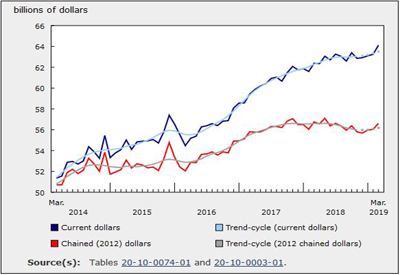What’s Hindering Your Marketing Department and Inhibiting Your Growth?

Sept 30, 2018
By Katrina Olson
A recent CEW article by David Gordon caught my eye. The headline was, Are Your Sales and Marketing Teams Inhibiting Growth?
As a marketing consultant, writer, and trainer, I recognized the challenges and barriers that David was writing about. We agree on many issues (and their causes) facing electrical distributors and marketers. But I also hear from marketing people all the time that the C-Suite is hindering their efforts which, in turn, hinders the company’s growth.
In his article, David quotes a study conducted by Jim Dickie of CSO Insights about how sales and marketing challenges can lead to sub-optimal performance. The survey was conducted with sales and marketing executives at the end of 2017, asking respondents what they saw as barriers within their companies. The results are illustrated in the chart below.
We can assume that there are underlying causes of these challenges or barriers to sales growth. The following section discusses some of them. Please note: several items in this chart are about sales, which is not my area of expertise, so I’ll focus on the marketing-related items.
• Difficulty differentiating against the competition. Marketing people can only work with what the company has to offer. What is the distributor doing to differentiate itself? Does it offer value-added services like inventory storage and management, technical support, or 24-hour ordering?
• Poor sales and marketing alignment. How does management encourage and reward alignment? Are incentives and recognition based only on sales? What processes and structures are in place to facilitate alignment?
• Ineffective use of CRM solutions. Is everyone properly trained and incentivized to use the CRM? Do they understand the benefits and how it makes their jobs easier or was it forced on them with little explanation? Is it used as a monitoring tool by management or as a sales and marketing tool to generate leads?
• Poor prospect/customer data quality. First, see the previous point. Has the company dedicated resources (e.g., software, people, time) to ensure high data quality? Is a specific person or department charged with managing and maintaining data? Has everyone “bought in” to inputting and sharing data?
The C-Suite must reward the behaviour it wants to see, and empower sales and marketing staff with the tools, training, personnel, and other resources to succeed.
How marketing should work
When practiced well, marketing is an art and a science. It’s based on research into the competitive environment and target audiences; planning based on the company’s history; and creative problem-solving based on the marketer’s skill and experience.
Further, marketing strategy is based on a solid business strategy. Assume a distributor sets a goal of growing sales by 20%. What is the business strategy for achieving that goal? Is it adding new products or services or expanding geographically? A marketer needs specific direction.
Now, let’s assume the C-Suite defines a goal of “growing the business by 20% by entering the hospitality market and selling $500,000 of energy efficient lighting, generators, vehicle charging stations, IoT solutions, solar and battery storage systems, and related products in the next year.” That’s a goal a marketer can build a plan and strategy around. (Of course, it must be based on research that supports the market potential.)
Now that the marketing department has clear direction, they can:
• familiarize themselves with the industry and competitive marketplace through research;
• develop a marketing plan for the hospitality industry that may focus on building brand awareness and generating a leads;
• set marketing goals and develop plans and strategies to achieve them;
• work with sales to set sales goals and develop strategies and tactics to achieve them; and
• execute the marketing plan’s strategies (e.g., trade advertising, inbound and outbound marketing) and tactics (e.g., print and digital advertising, e-mail marketing).
That’s the best case scenario, but marketing departments are easily distracted by demands for one-offs from the sales department, legacy events that have little true marketing value, non-marketing activities that fall to them, and of course, ordering hats and t-shirts. Those are the time-wasters. However, there are often bigger problems that keep marketing departments from doing their best work.
How the C-Suite really hinders marketing
Following are some possible ways distributors are hindering the marketing department’s and their own success.
• The company doesn’t have a business plan. Marketing and sales are not given direction, just a large sales goal (number) with no plan for achieving it.
• The C-Suite has unrealistic expectations. Marketing (usually marketing communications) is expected to achieve goals that are not aligned with metrics that marketing is capable of affecting. Marketing/marcom can create awareness, generate leads, share information, and communicate messages target audiences, but rarely does it directly sell the product. However, it can support the sales effort.
• Marketing staff aren’t prepared for the job. In some cases, they don’t have sufficient training and education to do their job. Staff are promoted internally from other departments and don’t have a mentor or role model. Further, they often don’t have a background or training in marketing, but are expected to know the discipline.
• Marketing staff need continuing education. The marketing landscape is changing rapidly. Even what they learned in college a few years ago is already outdated. Marketing staff must be encouraged to attend workshops and conferences to stay current.
• Marketing and sales don’t have the right tools. What’s in the marketing technology stack? Does the distributor have a CRM system, marketing automation tool, business intelligence software? (By the way, if the marketing staff aren’t asking for these tools, they should be.) Are computers, software, and other office equipment up to date?
• Marketing doesn’t have a big enough budget. Marketing staff are expected to do more with the same resources, with no additional budget for outsourcing, new hires, or technology. And again, maybe they’re not asking for more, but they should be.
• The C-Suite expects immediate decisions, results, and ROI. Implementing marketing and branding strategies, and learning and adopting new software and technology, and seeing results takes training, trial and error, and time. Changing people’s perceptions and habits is a long game.
If the C-Suite doesn’t lay the foundation for successful marketing in terms of planning, strategy, personnel, training, technology, and budget, they’re setting marketing and sales up for failure.
Perhaps the biggest challenge marketers face is that, too often, the C-Suite doesn’t recognize marketing as a strategic, management-level function. As a result, marketing staff are hired as entry-level tacticians such as writers, event coordinators, graphic designers, or webmasters.
But when their efforts don’t generate the expected results, management is surprised. But when marketing staff are hired well, receive continuing education, are empowered as strategists, and given a seat at the management table, they will be prepared to deliver their best possible effort for the company. And when the marketing team has the tools and support they need to succeed, they can be a distributor’s most powerful weapon.
Katrina Olson is a marketing consultant, trainer, speaker, columnist and content developer based in Central Illinois. She hosts a monthly podcast called Market Boldly available on iTunes, Google Play, and at KatrinaOlson.com. Katrina writes for tED magazine, lightEDmag.com, tedmag.com, The Current, and Hardwood Floors magazine, as well as content for several electrical distributor and manufacturer blogs and publications. She has judged tED magazine’s Best of the Best Competition since 2006 and spoken at several industry events for NAED, AD, and Legrand and more. She can be reached at Katrina@KatrinaOlson.com or through her website at www.katrinaolson.com.











